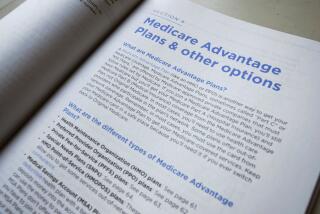Many opt for high-deductible health plans despite risks
Alice Marie Francis believes it’s important to have health insurance, but finding a plan that fit her budget was no easy task. “Money is tight,” says the 50-year-old Burbank mother of two, whose children are insured by their father’s work-based policy.
To make sure she had coverage that didn’t break the bank, she opted for a high-deductible health plan — an increasingly popular option with lower monthly premiums but high upfront costs before most insurance payments kick in.
High-deductible plans are typically recommended for younger policyholders who are in good health and have less need for doctor visits and prescription drugs, and for people with incomes high enough to cover the cost of routine medical care.
But patients like Francis opt for it anyway, despite the risks. She pays just $123 a month, but if she gets sick she’ll have to shell out $3,300 to meet her deductible before insurance helps her pay the bills.
As a result, Francis says she does whatever she can to avoid the doctor. “I ensure that I take very good care of myself,” she says.
For people like Francis who don’t have a lot of cash on hand, these policies can be a poor choice. Often, they hesitate to seek care when they become ill or injured.
Be careful if you move to a higher-deductible plan from one with a lower deductible, says Linda Blumberg, an economist and senior fellow at the Urban Institute, a Washington think tank.
“You’ve got to be putting away money as you go along so if something bad happens you’re prepared and you’re not in a situation where you can’t access the care you need.”
For Francis — and others with high-deductible policies — experts have plenty of advice on ways to access needed medical care and manage costs. It’s advice that can benefit everyone.
•Know your plan. Francis hasn’t had a mammogram or a routine checkup in years. She didn’t realize that despite her $3,300 deductible, she can get many preventive services at no cost.
“There is a required list of preventative services that have to be free under the Affordable Care Act,” says Cheryl Fish-Parcham, deputy director of health policy for Families USA, a healthcare advocacy organization in Washington. You can see the full list of covered services at HealthCare.gov.
Blumberg of the Urban Institute also suggests taking time to understand other basics of your plan, such as what services are included and excluded from coverage, and which doctors and hospitals are in the insurer’s provider network.
“Get as much information as you can about what services count toward the deductible and what counts toward out-of-pocket maximums,” she says.
•Stay in network. Getting care from your insurer’s network of doctors, clinics and hospitals will be less expensive than care received outside the network.
“Most of the time when you go to a physician or hospital in network, the cost of that service, while subject to a deductible, will still be at a discounted rate,” says Martin Rosen, an executive vice president of Health Advocate, a patient advocacy organization based in Plymouth Meeting, Pa.
•Sign up for a health savings account to set aside money for medical expenses. These HSAs are investment accounts that can be opened by anyone enrolled in a qualified health insurance plan. For 2013, a single person can sock away as much as $3,250 annually and a family can set aside as much as $6,450. If you’re 55 or older, you’re allowed to kick in an additional $1,000 each year.
The money you deposit goes in as a before-tax contribution and, as with a 401(k) account, accumulates tax free from year to year. The money can also be withdrawn tax free as long as it’s spent on qualified healthcare costs, such as dental care, doctor and hospital visits, eyeglasses and prescription drugs. Check out IRS Publication 502 for a list of qualified expenses.
•Shop for the best price and negotiate. The prices of medical procedures vary widely from one healthcare provider to another, even among those contracted with the same insurance company. For example, a study conducted last year for Catalyst for Payment Reform, a nonprofit organization working to improve how health services are paid for, found that the price for colonoscopies varied from one provider to another by as much as 1,000%.
For that reason it pays to shop around. Though healthcare prices are notoriously hard to pin down, Rosen suggests starting with a ballpark figure and then negotiating with providers, especially for elective procedures. Most health insurers offer a price comparison tool, as do many employers. In addition, websites such as FairHealthConsumer.org enable you to estimate potential costs for medical care in your area.
Francis still relies on her own methods for maintaining her health and saving money.
“I self-diagnose all the time,” she says. “The Internet is my best friend.”
Zamosky writes about healthcare and health insurance.






